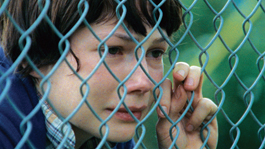home | metro santa cruz index | movies | current reviews | film review

lost: Michelle Williams searches for lots of things in 'Wendy and Lucy.'
Lucy Come Home
Michelle Williams is a lost soul in 'Wendy and Lucy.'
By Richard von Busack
It's not that Wendy and Lucy is mediocre; at about 80 minutes long, it doesn't have the time to be. The film has a simple story, too. Having left her family back in Muncie, Ind., Wendy (Michelle Williams) is driving an old Honda Accord to the fisheries in Alaska. With her is her part-Lab Lucy (played by the director's dog). In a nowhere town in north Oregon, Wendy's car refuses to start. Having lost her car, Wendy soon loses Lucy.
The craftsmanship in Kelly Reichardt's film shows through even in the earliest tracking shots. This is the kind of movie that's usually given the small-camera treatment, for budget reasons or to express more grit. Portland's Reichardt (Old Joy) and her two cinematographers (Samy Levy, with assistance from Greg Schmitt) worked hard on the composition and color. If you've ever had the foolish reverie of buying a sleeping bag and heading for the rail yards to hop a freight train up north, Wendy and Lucy visually idealizes that dream: at one point, Wendy (Michelle Williams) is a little blue riding hood in a boxcar cruising among the dreamy, foggy trees.
At the beginning of the film, Lucy discovers a group of train hoppers around a fire. The one professional among them (the musician Will Oldham) looks physically right, but when he starts to orate, telling a story about how he got in trouble up in the Alaska for driving some heavy equipment while stoned, the quiet naturalism of the scene is punctured. It turns theatrical in a hurry. The same problem occurs when Wendy is popped for shoplifting--an impulsive action, to feed her dog--John Robinson, playing the clerk trying to take the high ground on her, is clearly posing for a camera. "The rules apply to everyone," he says, as if he were playing a district attorney onstage. If Reichardt wants to escape the ghetto of being a great regional filmmaker, she's going to have to figure out a way to coordinate the acting styles in her films. As for the star, Williams can hit the notes. But nothing sticks out more than poised acting in a naturalistic film.
Unlike in Agnès Varda's 1985 classic, Vagabond, what happens to Wendy is never her fault. She has none of the usual problems of a wanderer; no tendency to drink or drugs, no alienating tattoos, no interest in hooking up with men or women. Reichardt prefers to present Wendy as an innocent version of everyone we ever ignored or refused to give spare change to. We can watch her and feel the panic of what might happen to us if we ran out of money or tried to make a break for it. The situations in Wendy and Lucy are plausible, and the film resolves on a point that's ancient-movie effective. It would have worked as well in 1909 as 2009. That might be enough for some audiences, who won't miss the answers to the questions about what Wendy's running from or what she's running to. Ask the average person what makes Wendy wander, and they'll say, "It's the economy, stupid." But the truth is that, unlike Sandrine Bonnaire's Mona in Vagabond, this Wendy is a stranger to us as much as she is to herself.
![]() WENDY AND LUCY (R; 80 min.), directed by Kelly Reichardt, written by Jonathan Raymond and Kelly Reichardt, photographed by Sam Levy and starring Michelle Williams, opens Friday at the Nickelodeon.
WENDY AND LUCY (R; 80 min.), directed by Kelly Reichardt, written by Jonathan Raymond and Kelly Reichardt, photographed by Sam Levy and starring Michelle Williams, opens Friday at the Nickelodeon.
Send a letter to the editor about this story.
|
|
|
|
|
|